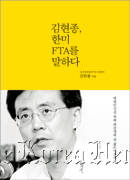Memoir of U.S.–Korea FTA
Kim Hyun-jong talks of U.S.―Korea FTA
By Kim Hyun-jong
(Hongsungsa, 19,000 won)

Kim Hyun-jong is the former minister for trade in the late President Roh Moo-hyun administration.
Being one of the central figures in the administration’s trade policy from 2003 to 2007, Kim initiated numerous free trade agreement (FTA) plans with Mexico, India, Canada, Singapore, MERCOSUR, EFTA, GCC, ASEAN, and the United States.
His latest memoir, “Kim Hyun-jong talks of U.S.-Korea FTA,” chronicles and unveils Kim’s four years of working as the minister for trade, initiating Korea’s FTA negotiations with the countries above ― especially the United States.
Kim first met the late President Roh back in 2003, who was rather hesitant of pursuing FTA at the time. Kim told Roh that FTA was one of the important measures to establish Korea as the central player in Northeast Asia.
Before signing FTA with Chile ― the first nation with which South Korea signed the deal ― in 2002, Korea was one of the only two countries,(out of 150 countries that had been registered in WTO), along with Mongolia, that did not have FTA with their trading partners.
Many nations at the time did not find Korea attractive as their FTA partner, for its lack of experience with FTA negotiations.
Yet Kim did not approach such strong economies as the U.S. and EU first. Instead, he initiated FTA negotiations with Canada, Singapore, and EFTA (European Free Trade Association), which later motivated the key FTA players to consider signing an agreement with the Roh administration, as they wanted to keep their share in Korea.
The U.S.-Korea FTA was first signed on June 30, 2007, and its renegotiated version was signed in early December of last year. Kim states in the book that he is not happy with the renegotiations of the agreement, as the U.S. agreed not to launch further negotiations in 2007.
Born in 1959 in Seoul, Kim earned both his undergraduate and law degrees at Columbia University in New York. He had worked as an associate at Milbank Tweed Hadley & McCloy and Skadden, Arps, Slate, Meagher & Flom in the United States, and as a staff lawyer for the WTO in Geneva before working for the Roh administration. He was ambassador of South Korea to the United Nations from 2007 to 2008. He currently works as the chief legal officer of Samsung Electronics.
(
clairelee@heraldcorp.com)
The men who made the modern world
The Clockwork Universe: Isaac Newton, the Royal Society, and the Birth of the Modern World
By Edward Dolnick
(Harper, $27.99)

In Europe of the 1600s, Edward Dolnick tells us, the average life expectancy was 30. Disease was so rampant that in London, deaths outnumbered births. Belief in the supernatural was commonplace, even among the intelligentsia. One leading scientist believed the best treatment for cataracts was blowing dried human feces into a patient’s eyes.
Amid such superstition, a small band of scientists ― mostly mathematicians and astronomers ― set out to decode the workings of the universe. Deeply religious themselves, they undertook their investigations to prove that God had indeed created a perfect, orderly world ― the “clockwork universe” of Dolnick’s title.
Yet when these men ― Galileo, Kepler, Descartes, Leibniz and most important, Isaac Newton ― discovered and described the forces that kept the Earth, the moons and all the planets spinning in their orbits, they inadvertently undermined belief in an all-powerful creator. They made God irrelevant by elevating science and technology, and in doing so, ushered in the modern era.
Dolnick, a former science writer at The Boston Globe, tells this story in short, punchy chapters, using simple language to explain complex ideas in math and physics. He diligently describes conditions at the time ― life was nasty, brutish and short, to quote the 17th-century great Thomas Hobbes ― to establish what a revolution in thought was under way.
For this reason, the first couple hundred pages of “The Clockwork Universe” feel like an extended introduction, albeit with entertaining digressions about colorful personalities like the diarist Samuel Pepys and satirist Jonathan Swift.
We also learn a great deal about the Royal Society, founded in London in 1660 to promote scientific inquiry, and whose members conducted experiments we would today consider insane (sheep-to-man blood transfusions) or deeply disturbing (dissections of live dogs).
Dolnick’s history begins to soar toward the end, when he focuses on Newton and his masterpiece “Principia.” In that 500-page work, which he wrote in less than two years, Newton declares his intention to “demonstrate the frame of the System of the World” and proceeds to do so, explicating everything from the motion of the planets, moon and tides to the path of comets and shape of the Earth.
Subramanyan Chandrasekhar, a Nobel Prize-winning astrophysicist who has studied the “Principia” in depth, tells Dolnick that normal scientists can imagine the discoveries of great scientists, even if they were too “stupid” to have thought of them first. “But I don’t think it’s possible for any scientist to imagine what it would have been like to be Newton,” he says.
After reading Dolnick’s book, you may find yourself going in a straight line at a steady speed ― part of Newton’s first law of motion ― to pick up a biography of the great man himself. (AP)








![[Today’s K-pop] Blackpink’s Jennie, Lisa invited to Coachella as solo acts](http://res.heraldm.com/phpwas/restmb_idxmake.php?idx=644&simg=/content/image/2024/11/21/20241121050099_0.jpg)
